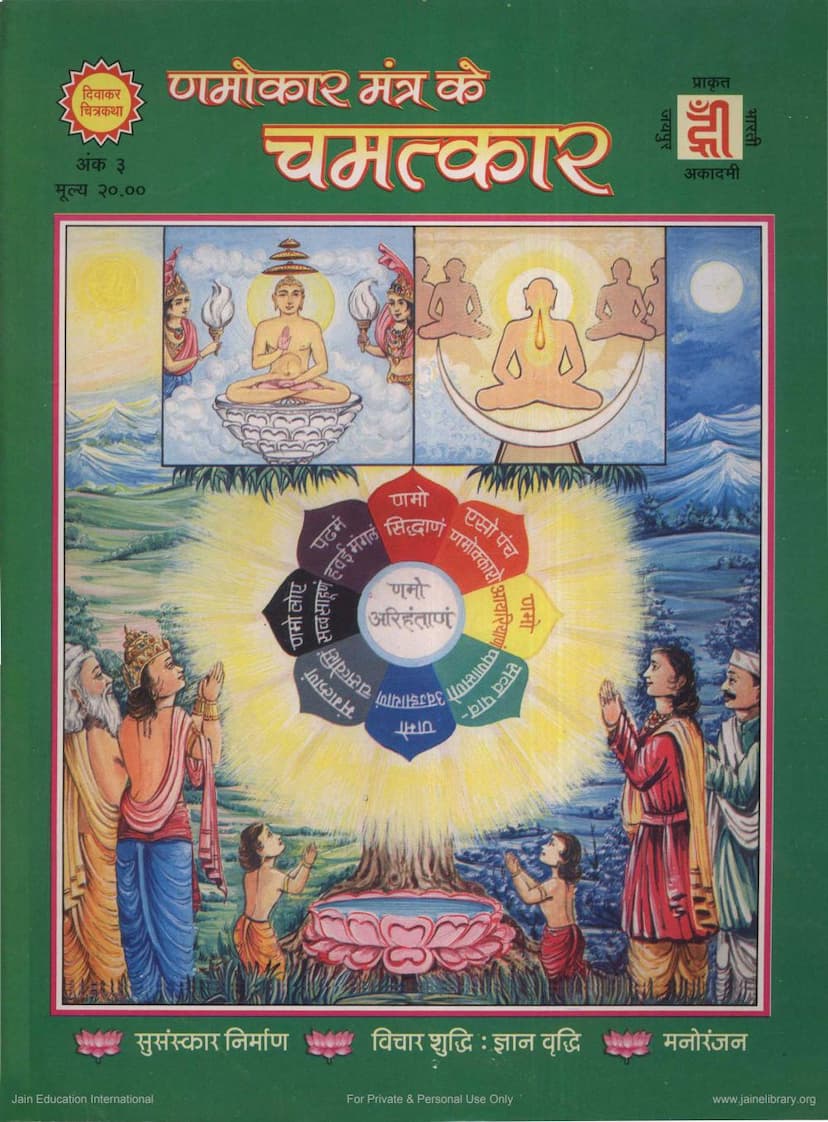Navkar Ke Chamatkar Diwakar Chitrakatha 003
Added to library: September 2, 2025

Summary
Here's a comprehensive summary of the Jain text "Navkar ke Chamatkar Diwakar Chitrakatha 003" in English:
This book, "Navkar ke Chamatkar Diwakar Chitrakatha 003" by Vishalmuni and Shreechand Surana, published by Diwakar Prakashan, is a collection of stories that illustrate the miraculous power of the Navkar Mantra, the fundamental prayer in Jainism. The book highlights that the Navkar Mantra is an eternal, perfected mantra that, when recited and meditated upon with faith, yields immediate results.
Core Message: The book emphasizes that the Navkar Mantra is a powerful tool for overcoming various life challenges, from physical ailments and adversities to spiritual upliftment. It asserts that sincere and regular recitation of the mantra can bring about significant positive changes in one's life, both material and spiritual.
The Navkar Mantra: The book prominently features the Navkar Mantra:
- णमो अरिहंताणं (Namo Arihantanam): Salutations to the Arihants (those who have conquered their passions and inner enemies).
- णमो सिद्धाणं (Namo Siddhanam): Salutations to the Siddhas (liberated souls who have attained perfection).
- णमो आयरियाणं (Namo Acharyanam): Salutations to the Acharyas (Jain ascetics who guide the path).
- णमो उवज्झायाणं (Namo Upadhyayananam): Salutations to the Upadhyayas (Jain scholars who teach scriptures).
- णमो लोए सव्व साहूणं (Namo Loye Savva Sadhunam): Salutations to all the Sadhus (ascetics) in the world.
It states that this five-fold salutation is a destroyer of all sins and the foremost auspicious chant. The 35 letters within these five terms are said to contain incredible mantra power. When recited with pure intentions and deep concentration, the resulting sound vibrations create an explosion of energy within, awakening spiritual powers and empowering the body's consciousness centers to overcome disease, sorrow, fear, and anxiety. The mantra is described as a protective shield against negative influences, harmful beings, and afflictions.
Stories within the Book:
The book presents three real-life or historical accounts to demonstrate the mantra's efficacy:
-
The Golden Man (Page 4-15): This is a detailed narrative about a wealthy couple, Yashobhadra and Shiva, who longed for a son. After diligently reciting the Navkar Mantra, their prayers were answered with the birth of a son, Shivkumar. However, Shivkumar grew up to be wayward, indulging in gambling and other vices, causing immense grief to his parents. After their demise, Shivkumar was left alone and destitute. In desperation, he sought help from a Tantric. The Tantric instructed him to bring a corpse for a ritual to gain wealth. During the ritual, as the Tantric attempted to empower the corpse, Shivkumar remembered his father's advice and recited the Navkar Mantra. The mantra's power protected him from the Tantric's dark magic. The demon summoned by the Tantric, after being thwarted by the mantra, transformed the corpse into a golden statue and instructed Shivkumar to live a virtuous life. Shivkumar, transformed by this experience, abandoned his vices and lived a righteous life, with unwavering faith in the Navkar Mantra.
-
Fire Became Water (Page 16-26): This story recounts the construction of a grand palace for King Shrenik in Rajagriha. However, the palace walls would inexplicably collapse every night. Despite attempts by architects and scholars to find the cause, the problem persisted. A special assembly concluded that this was an inauspicious sign indicating a threat to the king's life and kingdom. The royal priest suggested a human sacrifice in a yagna (fire ritual) to appease the deities. The king, hesitant about human sacrifice, announced a reward of gold equal to the weight of any auspicious son offered for the ritual. A poor Brahmin woman, Bhadra, offered her youngest son, Amarkumar, to alleviate their poverty. Amarkumar, terrified, remembered his guru's teachings about the Navkar Mantra. As he was being prepared for the sacrifice, he recited the mantra with deep faith. This caused a miracle: the sacrificial fire extinguished, a divine throne appeared, and Amarkumar was elevated to it. The king, realizing the boy's divine connection, apologized and offered him his kingdom. Amarkumar, disillusioned by the self-interest of family and rulers, declared his sole refuge would be the Navkar Mantra and advised the king to install the mantra at the palace gate for protection. The palace construction then proceeded without hindrance.
-
Life-Giving (Page 27-34): This is presented as a true incident about Gulab Chandbhai, a teacher in Jamnagar, Gujarat. He suffered from severe headaches and later developed throat cancer in its final stages, making it impossible for doctors to perform biopsies or offer effective treatment. Desperate and nearing death, he recalled the Navkar Mantra and began reciting it with complete surrender. The mantra's power led to a powerful emesis, expelling the toxic elements of the cancer from his body. He experienced a remarkable recovery, and subsequent medical examinations showed no trace of cancer. The story concludes with his testimony to his doctor about the miraculous power of the Navkar Mantra.
Key Takeaways:
- Faith and Devotion: The book consistently emphasizes that the effectiveness of the Navkar Mantra relies heavily on faith, sincerity, and devotion.
- Spiritual and Material Benefits: The mantra offers both material advantages (overcoming obstacles, achieving desires) and spiritual benefits (peace of mind, purification of the soul, good destiny).
- Overcoming Adversity: The stories illustrate how the mantra can be a powerful shield against dangers, diseases, and negative influences.
- Transformation: The narratives show how individuals transformed their lives from vice to virtue through the practice of the Navkar Mantra.
In essence, "Navkar ke Chamatkar" is a motivational and inspirational work that aims to instill faith in the Navkar Mantra and encourage readers to embrace its practice for personal growth and well-being. The book serves as a testament to the profound spiritual and practical efficacy attributed to this central Jain prayer.